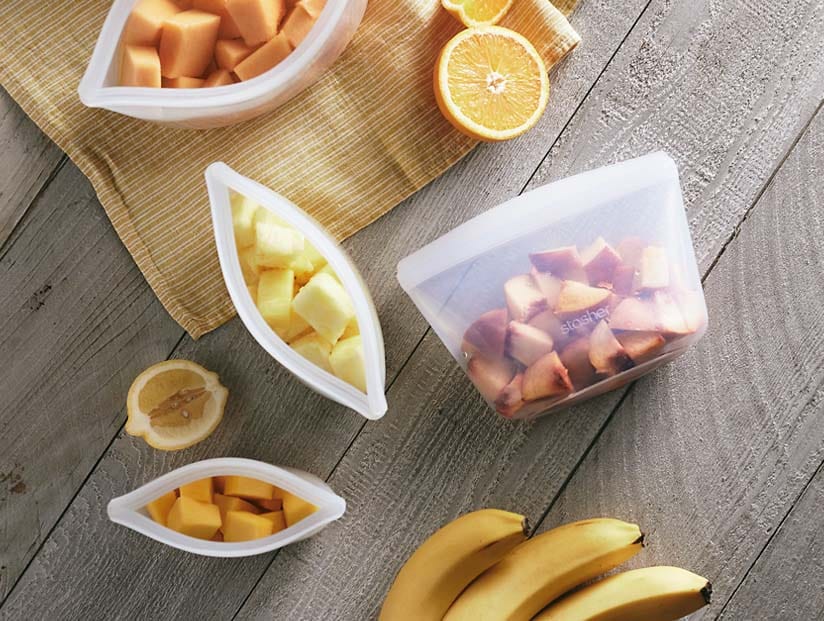
What to Wear Hiking in Summer
If you’re heading out for some summer hiking, it’s important to dress the part! Donning the right hiking clothes can make the difference between a miserable excursion (that you can hopefully laugh about later) and the best hike of your life. Don’t believe us? Read on, because we’re walking you through exactly what to wear when hiking—paired with the obvious, reusable accessories—in the summer for an optimal experience.
Hiking boots and shoes: what to look for
If you’ve ever peeled off your hiking socks after your trek to see a whole host of bright red blisters, then you already know the importance of wearing the right hiking boots and socks! And yes, there is such a thing as hiking socks – they’re usually wool (sometimes synthetic) and tend to be thicker than normal socks because they have a little extra cushion around the ball of the foot and the heel area. This extra padding makes for a more comfortable hike, but it also increases your socks’ durability (and earth friendliness!). Hiking socks might not be endlessly reusable like a Stasher bag, but their thicker construction means you can wear them for longer until they finally wear out and need replacing.
Likewise, good hiking shoes are also built to last. And selecting the right hiking boots or shoes for your feet and terrain of choice is crucial. There are a handful of things to keep in mind when choosing the right hiking boots for you, but most important is fit. The goal is to find Cinderella-esque hiking boots that aren’t too tight (think: pinched toes), aren’t too loose (heel sliding around), but are just right. (Pro tip: when searching for hiking boots, be sure to try them on with your hiking socks, not just whatever socks you happen to be wearing.) Most folks also need a decent amount of support and sole rigidity in their boots that will help provide balance on icy, slippery, rocky, and sharp surfaces. If you have wobbly or pronating ankles, look for boots that are extra rigid and snug around the ankle, too.
Because hiking boots tend to have such durable, solid construction, they’re usually not very breathable. If your feet sweat a lot (we won’t judge) or you’re going to be hiking through watery terrain, you’ll need more ventilation, so look for hiking boots that are specifically labeled as waterproof.
Pants, shorts and leggings for summer hiking
Just like with footwear, your hiking pants or hiking shorts should be ultra-durable so that you can navigate tricky terrain, climb over rocks, or pass by scratchy brush without fear of ripping the fabric. But sometimes with durability comes chafing. To remedy this, wear synthetic underwear, try thigh bands designed to prevent chafing during exercise, and pack an anti-chafing balm in stick form that you can quickly apply when needed.
A common phrase in the hiking and backpacking community is to “be bold, start cold.” In other words, you should be a tiny chilly (or, on summer days, at least not overly warm) when you’re just starting your hike, because your body is going to warm up a lot with the exertion. Convertible pants are a great way to navigate this transition in body temperature – wear them as pants as you first hit the road, and then zip them off into shorts as you start to heat up and sweat. And speaking of, it’s a good idea to look for quick-drying fabric that can wick away and evaporate sweat quickly so that you always feel dry and comfortable.
While protecting your skin from the sun is always a good thing, it tends to be especially top of mind in the summertime. Many hiking pants, shorts, or leggings have an UPF, or Ultraviolet Protection Factor, rating. Think of this as the fabric version of sunscreen’s SPF – the UPF tells you how much UV radiation will reach your skin through the fabric. (As an example, hiking pants that are UPF 50 means that those pants will block 98% of the sun’s rays on your legs.)
Another feature to consider in your hiking pants is storage — zippered or cargo pockets to hold valuables, first aid supplies, etc. If your pants are short on storage or you’d rather not pack your pockets, try clipping a reusable Stasher Go Bag to the belt loop — hikers love this bag for securely storing phones, snacks, and other items they want easily accessible.
Moisture-wicking tank tops and other top layers
Given the “be bold, start cold” mantra, dressing in lightweight layers of hiking clothes is helpful for temperature regulation. If you’re heading out on a chilly morning or climbing up to a higher elevation, you may want a mid-layer jacket (we love jackets from Patagonia and The North Face) that you can tie around your waist when not in use. Under that, you’ll want a t-shirt or tank top, and under that, a sports bra if you wear one. The idea is to be able to effortlessly don or shed extra layers throughout the hike so that you’re always as comfortable as possible. And as with hiking pants, look for hiking tops that are both moisture-wicking and UPF rated.

Sun hats, sunscreen and staying hydrated
Wearing UPF 50 hiking clothes, while helpful, isn’t going to protect you from pesky and painful sunburns entirely. Protecting your skin from the sun is important no matter the weather conditions, but it’s especially important in hot weather when you have more skin exposed and are more likely to get dehydrated. Optimal sun protection is a multi-layered effort that includes using waterproof sunscreen, wearing a sun hat and sunglasses, and staying hydrated. To make sure you’re properly fueled, keep Pocket Bags on hand filled with high-energy snack foods for hiking, and always hike with a water bottle or hydration reservoir if you’re using a backpack. And we like to use the Go Bag clipped to a backpack or belt loop to keep sunglasses and sunscreen close at hand.
Hiking in the summer is an awesome way to unplug, get outdoors and enjoy the weather. And doing your research on what to wear for hiking in the summer is key to ensuring your experience is a great and comfortable one. See you on the trails!







